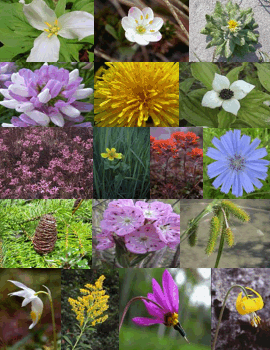Poa arctica R. Br.
arctic bluegrass
Poaceae (Grass family)
Introduction to Vascular Plants
arctic bluegrass
Poaceae (Grass family)
Introduction to Vascular Plants
Species Information click to expand contents
General:
Perennial, densely to loosely tufted grass from fibrous roots and rhizomes; stems usually decumbent, 7.5-60 cm tall/long.
Leaves:
Sheaths hairless, margins open 1/2-3/4 their length; sterile shoots mainly breaking through the sheath bases; basal bladeless leaves present; blades 1-4 mm wide, flat or folded; ligules (1) 2-7 mm long, the tips blunt or rounded to sharp-pointed, entire or torn, backs smooth or slightly rough.
Flowers:
Inflorescence a lax to erect panicle, (2) 3.5-15 cm long, sparse, egg-shaped to broadly pyramidal, usually open; lowermost internodes less than 1.5 (3) cm long, the branches 1 to 5 per node, ascending or widely spreading, round, smooth or slightly to moderately rough, spikelets not crowded, longest lowermost branches 2/5-3/5 the length of the panicle; spikelets laterally compressed, 4-8 mm long, (2-) 3- to 6-flowered, sometimes with bulbils; glumes lanceolate to broadly lanceolate, keels indistinct, smooth or slightly rough near the tips, the lower ones 3-nerved, the upper usually nearly equalling to slightly exceeding the lower lemmas; rachillas smooth, hairless or sparsely minutely soft to long silky-hairy; lemmas lanceolate to broadly lanceolate, 3.5-7 mm long, the tips sharp-pointed, margins broadly translucent, surface smooth, keel and marginal nerves long silky-hairy, lateral nerves silky-hairy, mostly short silky-hairy between the nerves, lateral nerves prominent; calluses sparsely to copiously hairy; palea keels silky-hairy most of the length (rarely nearly hairless), minutely soft-hairy (or with at least a few, minute, straight hairs) between the keels; flowers bisexual (some appearing female due to aborted anthers); anthers sometimes aborted late in development or if present, 1.4-2.5 mm long.
Notes:
Two subspecies occur in BC:
1. Spikelets mostly greater than 6 mm long; lower lemmas 4.5-6 mm long; stem leaf blades often flat and more than 2 mm wide................... ssp. lanata (Scribner & Merr.) Soreng
1. Spikelets less than 6 mm long; lower lemmas 3-4.5 mm long; stem leaf blades mostly folded and less than 2 mm wide................... ssp. arctica
Ecology click to expand contents
Ecological Framework for Poa arctica
The table below shows the species-specific information calculated from
original data (BEC database) provided by the BC Ministry of Forests and Range.
(Updated August, 2013)
The table below shows the species-specific information calculated from
original data (BEC database) provided by the BC Ministry of Forests and Range.
(Updated August, 2013)
| Site Information |
Value / Class |
||
|
Avg |
Min |
Max |
|
| Elevation
(metres) |
1806 | 5 | 3000 |
| Slope
Gradient (%) |
25 | 0 | 100 |
|
Aspect (degrees) |
192 | 0 | 360 |
| Soil
Moisture Regime (SMR) [0 - very xeric; 4 - mesic; 8 - hydric] |
3 | 0 | 8 |
| Modal
Nutrient Regime
Class |
C | ||
| #
of field plots species was recorded in: |
524 | ||
| Modal
BEC Zone Class |
BAFA | ||
|
All BEC Zones (# of stations/zone) species was recorded in |
AT(59), BAFA(191), BWBS(6), cma(3), ESSF(153), IMA(26), MH(18), MS(5), SBPS(2), SBS(1), SWB(34) | ||
|
Source:
Klinkenberg 2013
|
|||
Habitat and Range click to expand contents
Moist to wet meadows, gravel bars and stream sides in the montane to alpine zones; ssp. arctica - frequent throughout BC; ssp. lanata - locally frequent in NW BC (poorly defined elsewhere); ssp. arctica - circumboreal, N to AK, YT and NT, E to NS, S to WA and NM; Iceland, Eurasia; ssp. lanata - amphiberingian, N to AK, YT and NT; E Asia.
